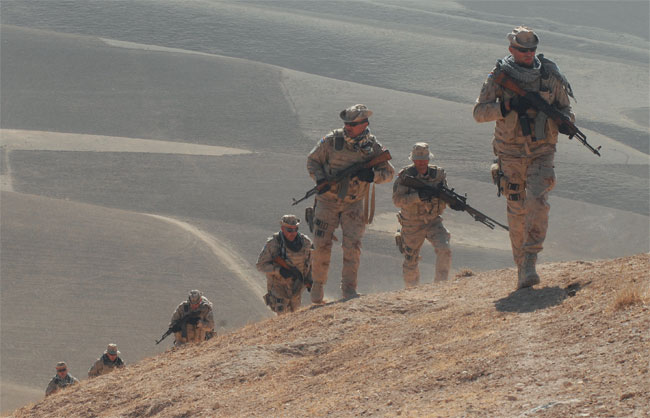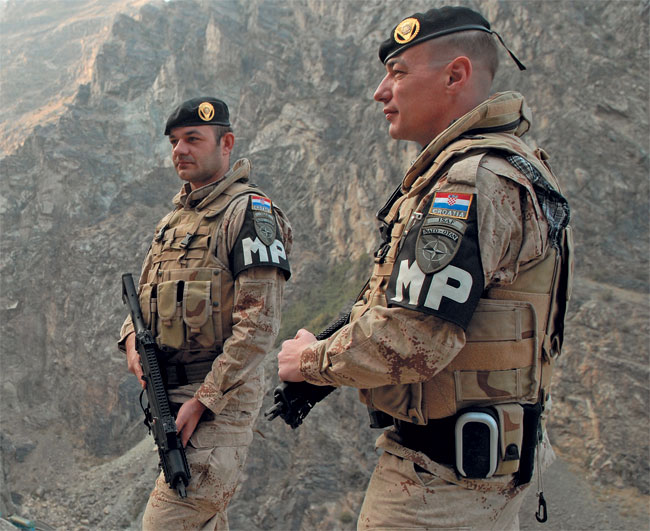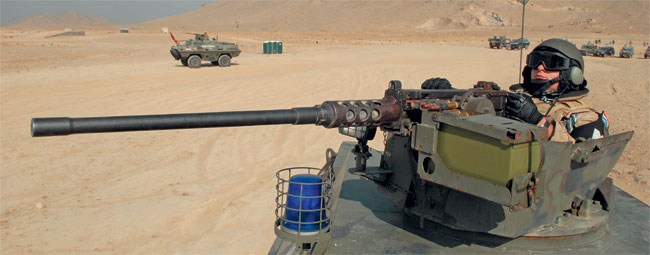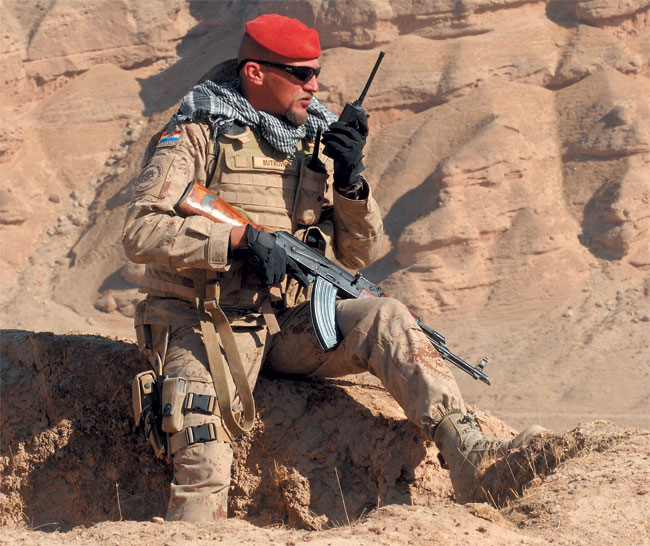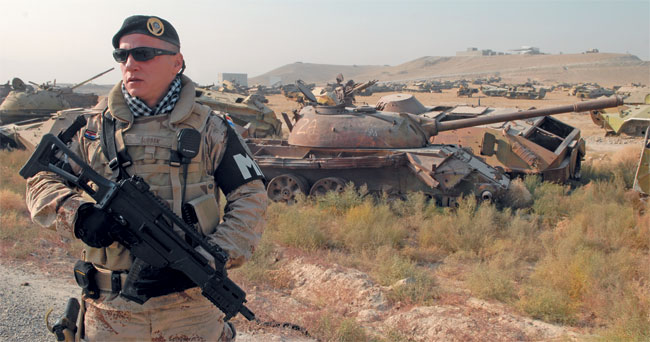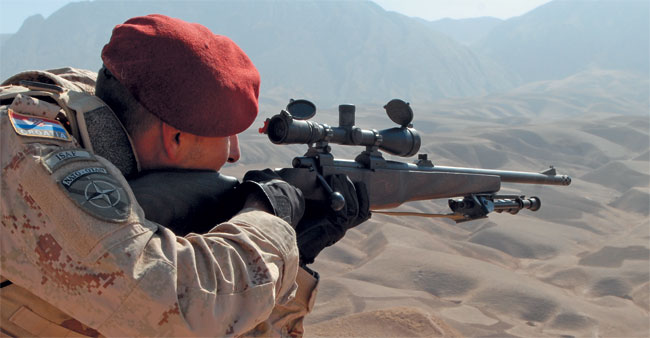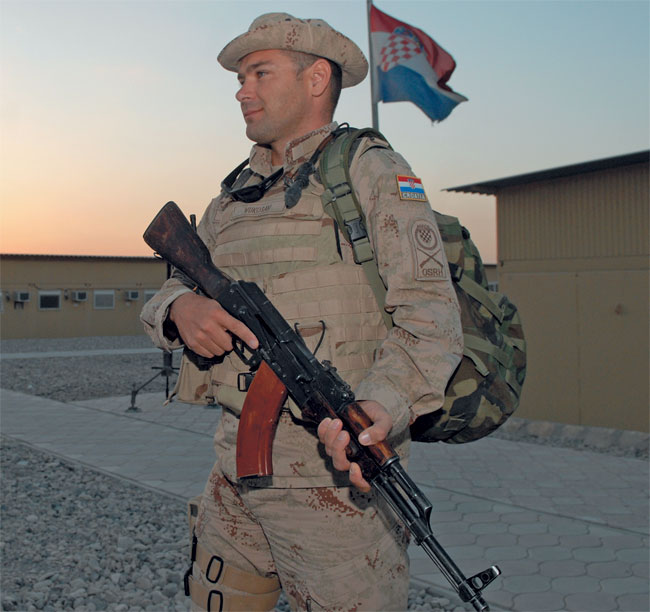ABOVE: Croatian soldier shoulders the Zastava made PKM – the M84, in 7.62x54R caliber.
The Croatian Armed Forces are changing from an army of defenders of their homeland, and becoming an Armed Forces that are preparing for entry into Euro-Atlantic political-military associations. They have become an army that contributes to building peace and stability, by taking part in peacekeeping missions under leadership of the UN or NATO. From a country that was the recipient of peace missions during the Homeland War, Croatia and its Armed Forces have, in a very short time, become an important factor in establishing and keeping peace in the world. Participation in peace missions is undoubtedly a confirmation of the maturity of the state that sends them and development and capabilities of the armed members for foreign countries for participation in peacekeeping operations occurred in February 2003, when a unit of our Armed Forces – the MP platoon was sent to peace mission ISAF in Afghanistan. The number of members in mission ISAF has increased in time so that the MP platoon has become a basis of the wider Croatian contingent. The year in question- 2007, it had reached 200 members. The tenth national contingent was deployed implying that already ten six-month rotations had been carried out since beginning the mission. In 2013, the 22nd contingent arrived for ISAF. In that time period, the Armed Forces gained a significant experience in the mission that was also reflected in their engagement in the field. Members of the first contingent were mainly members of the Military Police deployed only to one location – in the capital of Kabul. Nowadays Croatian soldiers are deployed also in the North, in Mazar-e-Sharif and in the West of Afghanistan, in Chagcharan and there is a possibility of temporary deployment to other parts of Afghanistan. Tasks that are carried out are also more complex and diversified – except the military police platoon, a platoon for protection tasks is also in the mission, a medical team, liaison and reconnaissance mobile team, mentoring team for training, staff officers, an officer for CIMIC (civil-military cooperation), etc.
In the first phase it was exclusively a military engagement but with the gradual gaining of field experience, the civilian component was brought in. Since January 2005, besides members of the Armed Forces in Afghanistan, Croatian civil servants, diplomats and policemen, have been active. The civilian team has been deployed within German Provincial Reconstruction Team (PRT) in Feyzabad, in the capital of the region Badakhshan, in the end north east of Afghanistan. The Croatian civilian team is mainly engaged in screening the existing state in local judicature and police and in providing support and advising institutions of local government, especially Afghan National Police.
Croatian soldiers in Afghanistan have received many commendations for their past work for a high level of professional quality in carrying out their duties. Our intention was to note in words and pictures, the moments of their stay and work in mission ISAF.
Establishment of the Mission ISAF and the Political and Legal Framework
ISAF (International Security Assistance Force) is an international military mission in the Islamic Republic of Afghanistan that has been led by NATO since August 2003. Prior to that, ISAF operated under mandate of the United Nations, in three six-month rotations, pursuant to Chapter VI of the UN Charter. In that period, it was led and coordinated in six-month rotations by Great Britain (ISAF I) Turkey (ISAF II) and jointly FR Germany and the Netherlands (ISAF III).
Since late 2001 ISAF has been an Operation in Support of Peace. It was then the so-called “Coalition of the Willing,” in which states that took turn in leadership had the biggest role: Great Britain, Turkey, the Netherlands and Germany. At the end of the first year of the mandate, 19 states under the UN mandate took part in the mission. However, the UN neither organized them nor provided financial assistance. ISAF has never been the UN observer mission.
Mission ISAF became NATO led military Peace Support Operation in 2003, when the UN changed the mandate in conformity with Chapter VII of the UN Charter, allowing use of force in peace support, in line with Rules of Engagement. With regard to such leadership and the concept of planning in NATO, financing of the operation is partly carried out from NATO’s common fund and partly states that participate in the operation give their contribution, regardless if they are members of the NATO or not.
The UN Security Council assessed that situation in Afghanistan represented a threat to international peace and security. The UN have therefore recommended to their member states to assist the operation ISAF by providing personnel, equipment and other resources and funds, especially the fund established for that purpose. The participation of the states with their donations is also important for ISAF.
ISAF Participants
Before NATO took over leadership of the operation ISAF, 28 states with approximately 5,400 soldiers took part in it. The number of the participating states increased afterwards and the operation became more complex and demanding. The criteria and manner of participating in the ISAF mission have been set according to Rules of Engagement in peace support and standards of military operations in NATO.
The greatest number of the countries participating in ISAF are NATO’s members, at the moment twenty-six of them. Eleven states that are not NATO’s members are included in the operation. They are mostly members of NATO’s programme Partnership for Peace. Australia, Austria, Albania, New Zealand, and Switzerland also take part in the operation ISAF in Afghanistan. Almost 35,500 soldiers are under direct command of NATO Headquarters.
Besides units under NATO’s command, about 5,500 members of national support elements have been deployed to mission ISAF and are under direct command of national headquarters.
The condition of military participation of the states that are not NATO’s members is to obtain a certificate on adequate interoperability with NATO and possess requested capabilities of units that will take part in the operation.
Preparations for Participation of the Croatian Armed Forces in the Mission
The Croatian Parliament decides how many CAF members may be sent to peace mission ISAF at one time. The Government reaches a decision on the number of members and structure of the unit, respectively the number of individuals who are sent on one-time basis. The President of the Republic of Croatia, as Commander-in-Chief of the CAF, makes a decision with a detailed description of sending the mission. A report is submitted to the Croatian Government after the return of each group and an annual report is submitted to the Croatian Parliament. As required, a separate report is submitted to the Parliamentary Committee for Internal Politics and national Security.

All members of the CAF who participate in ISAF make a voluntary decision, confirming it with a Statement of Voluntariness. They are qualified for and are equipped accordingly.
Role of the CAF and Coalition Forces
Mission ISAF, with its security forces, provides support to the Afghan Government in establishment and keeping peace and security so as to expand the area of central authority from the capital to the entire territory. Preconditions would be created for a faster reconstruction of the state and building of the society and contribute significantly to regional stability. The international community has put a lot of effort in achieving the common goal to develop a sustainable, stable and democratic Afghanistan. Visible progress has been realized in the last five years but there are still many challenges in the years to come. It is important to mention that democratic institutions have been developing from the beginning. Children, including girls, are back in schools and women take part in political life. The Afghan economy has been slowly developing and searches again for its place in world economic trends: reconstruction of the country that was destroyed by a 25-year long-term turmoil. The international community has invested significant funds in improving the life of the Afghan people. Although Afghanistan is still one of the poorest countries, its economy has significantly development so the GDP is nowadays almost three times larger than in 2001.
The first PRT was formed in early 2004 in the area of today’s Regional Command North. That was the German pilot-project in Kunduz. The wish was to expand the reach of the central Afghan authority and the zone of security farther from Kabul. Most of the PRTs were formed in northern and western Afghanistan, although there are some in the south and east. In early 2007 there were 25 PRTs.
Each PRT is organized and led by one state that possibly brings in another state – a co-leader. Other countries participate with their soldiers or units as support to implementation of projects worked out and planned by the leading state which bears a great part of expenses besides those agreed upon to be shared among states that participate in operation of the PRT.
Members of the CAF in ISAF are active in PRT Chaghcharan to the west of Afghanistan and in PRT Pol-e-Khomri to the north. Regarding that Croatia was planning to take over one PRT in 2008, the competent bodies of the state administration were carrying out appropriate preparations. The transitional phase in taking over is, inter alia, an intensive participation in PRT’s activities with the state that leads it during a certain period of time.
Participation in the ISAF mission and all lessons learned will help development of the CAF professional composition and of each soldier, NCO and officer so that they could continue to be a role model to other states in southeastern Europe.
Photos and text courtesy:
- Ministarstvo Obrane Republike Hrvatske Samostalna Služba za Odnose S Javnoscu I Izdavaštvo
- Odjel Hrvatskih Vojnih Glasila I Izdavašta
- Ilica 256b, Objekt 7/1, Zagreb, Croatia




